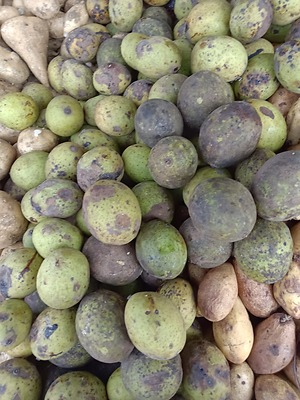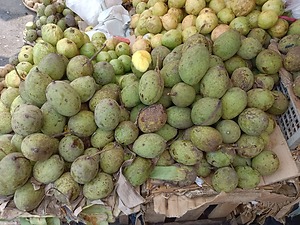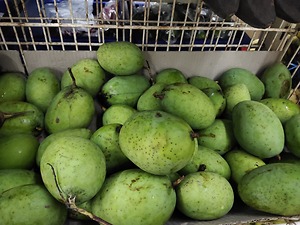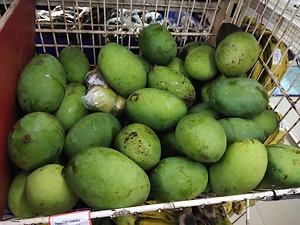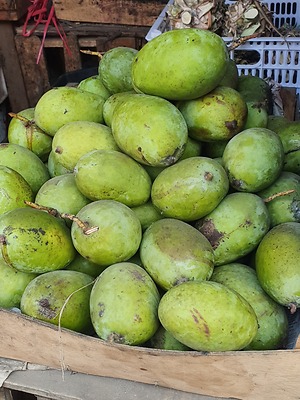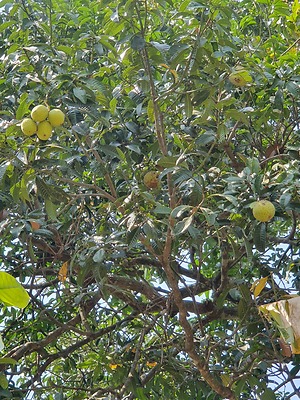


Horse Mangoes
Estimated Inventory, lb : 0
Description/Taste
Horse mangoes are medium to large in size, averaging 7-14 centimeters in diameter and are globular, oblong, to ovoid in shape. The smooth skin is approximately five millimeters thick and transforms from a solid yellow-green to a green base covered in brown lenticels and dark green spots. The skin may also be covered in a sticky sap that can be irritating to the skin. Underneath the matte skin, the yellow-orange flesh is juicy, fibrous, and contains a single cream-colored seed that is three centimeters in diameter and is enveloped in a brown, fibrous shell. Horse mangoes have a strong aroma and a slightly sour or bitter taste that is said to be similar to turpentine.
Seasons/Availability
Horse mangoes are available in the fall through early winter in tropical, rainforest climates.
Current Facts
Horse mangoes, botanically classified as Mangifera foetida, are drupes that grow on large perennial, evergreen trees reaching up to forty meters in height and belong to the Anacardiaceae family. Also known as Mamut, Limus, Bachang, Salom, and Mancang, Horse mangoes are native to the tropical regions of Southeast Asia and belong to the same family as the common mango Mangifera indica but have a different texture and flavoring. The sour flavor of Horse mangoes lends itself well to savory, cooked applications and is favored for its acidity to balance sweet notes in curries and chutney.
Nutritional Value
Horse mangoes contain vitamins A and C, potassium, thiamine, phosphorus, and calcium.
Applications
Horse mangoes are best suited for both raw and cooked applications such as sautéing and boiling. It is important to note that the skin must be peeled prior to consumption as it contains a sticky sap that can irritate the skin and mouth and should be handled with care while peeling. Once peeled, the flesh can be cubed and tossed into salads, incorporated into fruit cocktail, or juiced and mixed with sweeteners as a fresh drink. Horse mangoes can also be used fresh and mixed into vegetable salads for added flavoring, minced into chutney, or pickled for a sour tang. In cooked preparations, Horse mangoes are commonly cooked into curries and rice dishes. Horse mangoes pair well with cucumber, passionfruit, pineapple, coconut, lime, rice, meats such as pork, poultry, beef, and fish, cinnamon, anise, and peppermint. The fruit will keep up to one week when stored at room temperature.
Ethnic/Cultural Info
In Southeast Asia, folk medicine traditionally looks to surrounding nature as a healing ingredient in medicine and as a source of nutrition. Such is the case with the Horse mango in Indonesia. The leaves of the Horse mango tree are used medicinally in folk medicine in Kalimantan to help reduce symptoms of fevers. The sap is also used by the Dayak tribe in Kalimantan to deepen the color of tattoos as the sticky liquid irritates the skin increasing scar discoloration. In addition to medicinal uses, Horse mangoes are a staple ingredient in chutneys and are used as a sour flavoring in sambal, which is a spicy condiment that is a common household flavoring in Southeast Asia. In Java, the seeds of the Horse mango are ground into a flour and are mixed as a thickening agent in dodol, which is a popular sticky, sweet that has a toffee-like texture.
Geography/History
Horse mangoes are native to Southeast Asia and have been growing wild since ancient times in tropical regions of high-density rainforest. Today the drupe is still largely localized to Southeast Asia and can be found in the wild, cultivated on a small scale, and sold at fresh markets in Thailand, Vietnam, Malaysia, Singapore, Indonesia, Borneo, Philippines, and Cambodia.
Recipe Ideas
Recipes that include Horse Mangoes. One
| Cooking Chapter |
|
Horse Mango for Dessert |



